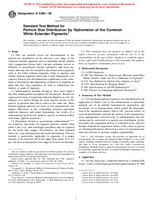Potřebujeme váš souhlas k využití jednotlivých dat, aby se vám mimo jiné mohly ukazovat informace týkající se vašich zájmů. Souhlas udělíte kliknutím na tlačítko „OK“.
ASTM D3360-96
Standard Test Method for Particle Size Distribution by Hydrometer of the Common White Extender Pigments (Withdrawn 2003)
Automaticky přeložený název:
Standardní zkušební metoda pro Distribuce velikosti částic podle Hydrometer společné White Extender Pigmenty (Withdrawn 2003 )
NORMA vydána dne 1.1.1996
Informace o normě:
Označení normy: ASTM D3360-96
Poznámka: NEPLATNÁ
Datum vydání normy: 1.1.1996
Kód zboží: NS-23416
Počet stran: 5
Přibližná hmotnost: 15 g (0.03 liber)
Země: Americká technická norma
Kategorie: Technické normy ASTM
Anotace textu normy ASTM D3360-96 :
Keywords:
Extender pigments, Particle size analysis-paints/related coatings/materials, Pigment dispersion (paints/related coatings/materials), Pigments-white, Pigments (general properties)-dispersions, White pigments-general analysis, particle size distribution, by hydrometer of common white extender, pigments, ICS Number Code 87.060.10 (Pigments and extenders)
Doplňující informace
| 1. Scope |
|
1.1 This test method covers the determination of the particle-size distribution in the sub-sieve size range of the common extender pigments such as aluminum silicate (kaolin clay), magnesium silicate (talc), calcium carbonate (calcite or dolomite or precipitated calcium carbonate), and mica pigments, and may also be extended to the denser prime pigments such as the white titanium pigments (rutile or anatase) and similar mineral pigments when and if such information is of concern. Particle-size distribution has significance in the evaluation of rheological and pigmentary properties of pigments in paint and also may sometimes be used to characterize the identity or grade of pigments. 1.2 Sedimentation methods having as their basis Stoke's law have found general acceptance for this purpose. Results are expressed in terms of equivalent spherical diameter (e.s.d.), the diameter of a sphere having the same specific gravity as the particle in question and which settles at the same rate. Most mineral pigment particles are more-or-less asymmetrical, but despite differences in the relationship between equivalent spherical diameter and actual dimensions, the results of a sedimentation particle-size analysis can be correlated readily with many pigment properties. 1.3 Procedures limited to gravitational sedimentation are relatively inaccurate for pigment particles smaller than about 1 [mu]m e.s.d., and centrifugal procedures may be required for the much finer ranges. Nevertheless, the data obtained above the 1 [mu]m limitation provide useful information. This method is particularly applicable to pigments if a major fraction of the particles fall in the range from about 15 to 1.5 [mu]m, but have a total particle-size range of at least two decades. 1.4 This standard does not purport to address all of the safety concerns, if any, associated with its use. It is the responsibility of the user of this standard to establish appropriate safety and health practices and determine the applicability of regulatory limitations prior to use. |
Odebírejte informace o nově vydaných normách ZDARMA:
Chcete pravidelně odebírat informace o nově vycházejících normách z celého světa a to zcela zdarma?
Přihlašte se k odběru. Vše je velice jednoduché a absolutně ZDARMA.
Na výběr máte vydavatele z celého světa.




 Cookies
Cookies
